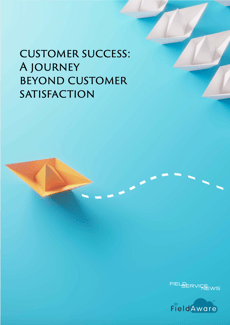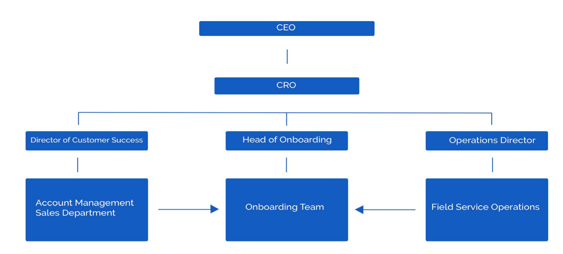Does a Focus on Customer Success Require a Shift in Management Structure?
Nov 12, 2021 • Features • White Paper • FieldAware • Leadership and Strategy • customer experience • customer success
In the second feature from a recent white paper we published in partnership with FieldAware, we analyse the need of a shift in management structure for service organisations with a customer success focused model.

This feature is just one short excerpt from a recent white paper we published in partnership with FieldAware.
www.fieldservicenews.com subscribers can read the full white paper now by hitting the button below.
If you are yet to subscribe you can do so for free by hitting the button and registering for our complimentary subscription tier FSN Standard on a dedicated page that provides you instant access to this white paper PLUS you will also be able to access our monthly selection of premium resources as soo as you are registered.

Data usage note: By accessing this content you consent to the contact details submitted when you registered as a subscriber to fieldservicenews.com to be shared with the listed sponsor of this premium content FieldAware who may contact you for legitimate business reasons to discuss the content of this white paper, as per the terms and conditions of your subscription agreement which you opted into in line with GDPR regulations and is an ongoing condition of subscription.
Suppose we consider customer success more in line with a servitization model than simply increasing CSAT metrics. In that case, we may start to see a more straightforward path towards developing the model. However, this
also leads us to conclude that such a shift in focus for a service organization will require significant changes within processes and potentially a change in management structure.
The established servitization models are centred around establishing long- standing partnerships between the service provider and the customer. Indeed, as we look at many of the high-profile examples of servitization, often in the early adoption of such service strategies, not only is customer selection crucial, very often, the evolution of the service model is one of genuine co-creation.
One acknowledged approach in developing such forward looking service design is establishing a tiger team – a group of specialists dedicated to the project full- time. In the co-creation model, such a team can comprise both organizations bringing in their specialist expertise, knowledge and insight. Additionally,
both organizations also develop the new approach parallel to existing service agreements, which is especially important when considering the mission-critical status that field service operations hold.
However, once the proof of concept is established, should the service provider wish to roll out a more comprehensive servitized offering, a clear management structure to facilitate the effective rollout is required.
We would expect to see an executive-level leader at the top of this structure – ideally reporting directly to the CEO.
Such a position may come in several guises. One option is the role of a chief revenue officer (CRO), which we are beginning to see emerge as a blend of the two roles of Chief Service Officer and Chief Sales Officer.
Another alternative could be Vice President of Customer Success. For ease of reference, we shall use the term CRO in this paper. Regardless of the name, the function of the role remains the same.
This is a position that requires an intimate understanding of where the value proposition of the service provider lies within the eyes of the customer (to drive successful approaches to revenue generation), while simultaneously having detailed knowledge of how the service operations can effectively meet the service delivery requirements while retaining efficiency both in terms of internal costs but also meeting the customer goals.
In addition to both of these skillsets, the potential CRO must also have the broader business acumen and insight to see how such a move will impact and draw upon other aspects of the organization as well – from R&D through to marketing.
Beneath the CRO, a hypothetical management structure could be mapped out into three key areas as per the graphic below.

On the left-hand side, we have a customer success team led by a director of customer success.
This would be a business division that evolves from the traditional sales team – with a heavier emphasis from account management on customer success and account development – i.e. building those long-standing, more deeply embedded relationships discussed earlier.
On the right-hand side, this structure is where our service operations business unit sits under the leadership of an operations director.
On this side of the operation, the shift in focus is perhaps less pronounced than the sales operation. In one sense, little changes in seeking the maximum efficiency and operational metrics such as technician utilization, mean-time-to- repair and first-time-fix rates remain as crucial as ever.
Ultimately, even in a fully servitized business model, the SLAs to be adhered to remain the same; however, they move from being an external agreement with the customer to being an internal requirement designed to allow the service operation to meet the guarantees of uptime that are now the bedrock of service contract.
However, we see a potential new business unit emerge in the centre of this new management structure – one dedicated to onboarding. In this case, it is also important to note that onboarding isn’t limited to new customers.
" While a similar structure could be adopted for various types of servitized offering, be it outcome-based service or a customer success focused model, the evolutionary leap from a csat focus will very likely involve both executive- level support and some restructuring of management structure..."
Most service organizations adopting such an approach will be taking their existing customers from a service model that they have been comfortable with for a long time to a far more holistic and encompassing model of service delivery.
Such significant change will almost always face some form of resistance. It is essential to have this interim team in place to help guide the customers through the transition from what is often a transactional relationship initially to one that becomes a true partnership.
Ideally, this onboarding team will bring a blend of in-depth operational experience and fantastic account management skills. A recommended approach could be to draw from both the operations and sales sides of the business to establish this new business unit.
This is, of course, just one hypothetical and fairly straightforward management structure to help illustrate the point. Many more complex variations could be implemented to achieve the effective development of a servitized or customer success-focused business model.
What is clear, though, is that while a similar structure could be adopted for various types of servitized offering, be it outcome-based service or a customer success focused model, the evolutionary leap from a CSAT focus will very likely involve both executive-level support and some restructuring of management structure.
Another critical aspect essential to the successful adoption of such a model is the easy flow of data across business units and the proper technological infrastructure to ensure that the service operation can operate at maximum efficiency – which we will discuss in the next feature from this white paper.

This feature is just one short excerpt from a recent white paper we published in partnership with FieldAware..
www.fieldservicenews.com subscribers can read the full white paper now by hitting the button below.
If you are yet to subscribe you can do so for free by hitting the button and registering for our complimentary subscription tier FSN Standard on a dedicated page that provides you instant access to this white paper PLUS you will also be able to access our monthly selection of premium resources as soo as you are registered.
 Data usage note: By accessing this content you consent to the contact details submitted when you registered as a subscriber to fieldservicenews.com to be shared with the listed sponsor of this premium content FieldAware who may contact you for legitimate business reasons to discuss the content of this white paper, as per the terms and conditions of your subscription agreement which you opted into in line with GDPR regulations and is an ongoing condition of subscription.
Data usage note: By accessing this content you consent to the contact details submitted when you registered as a subscriber to fieldservicenews.com to be shared with the listed sponsor of this premium content FieldAware who may contact you for legitimate business reasons to discuss the content of this white paper, as per the terms and conditions of your subscription agreement which you opted into in line with GDPR regulations and is an ongoing condition of subscription.
Further Reading:
- Read more about Digital Transformation @ www.fieldservicenews.com/digital-transformation
- Read more about Data Management @ www.fieldservicenews.com/data-management
- Read more about FieldAware on Field Service News @ www.fieldservicenews.com/exel
- Learn more about FieldAware @ www.fieldaware.com
- Follow FieldAware on Twitter @ twitter.com/fieldaware






















 Field Service News is published by 1927 Media Ltd, an independent publisher whose sole focus is on the field service sector. As such our entire resources are focused on helping drive the field service sector forwards and aiming to best serve our industry through honest, incisive and innovative media coverage of the global field service sector.
Field Service News is published by 1927 Media Ltd, an independent publisher whose sole focus is on the field service sector. As such our entire resources are focused on helping drive the field service sector forwards and aiming to best serve our industry through honest, incisive and innovative media coverage of the global field service sector.
Leave a Reply